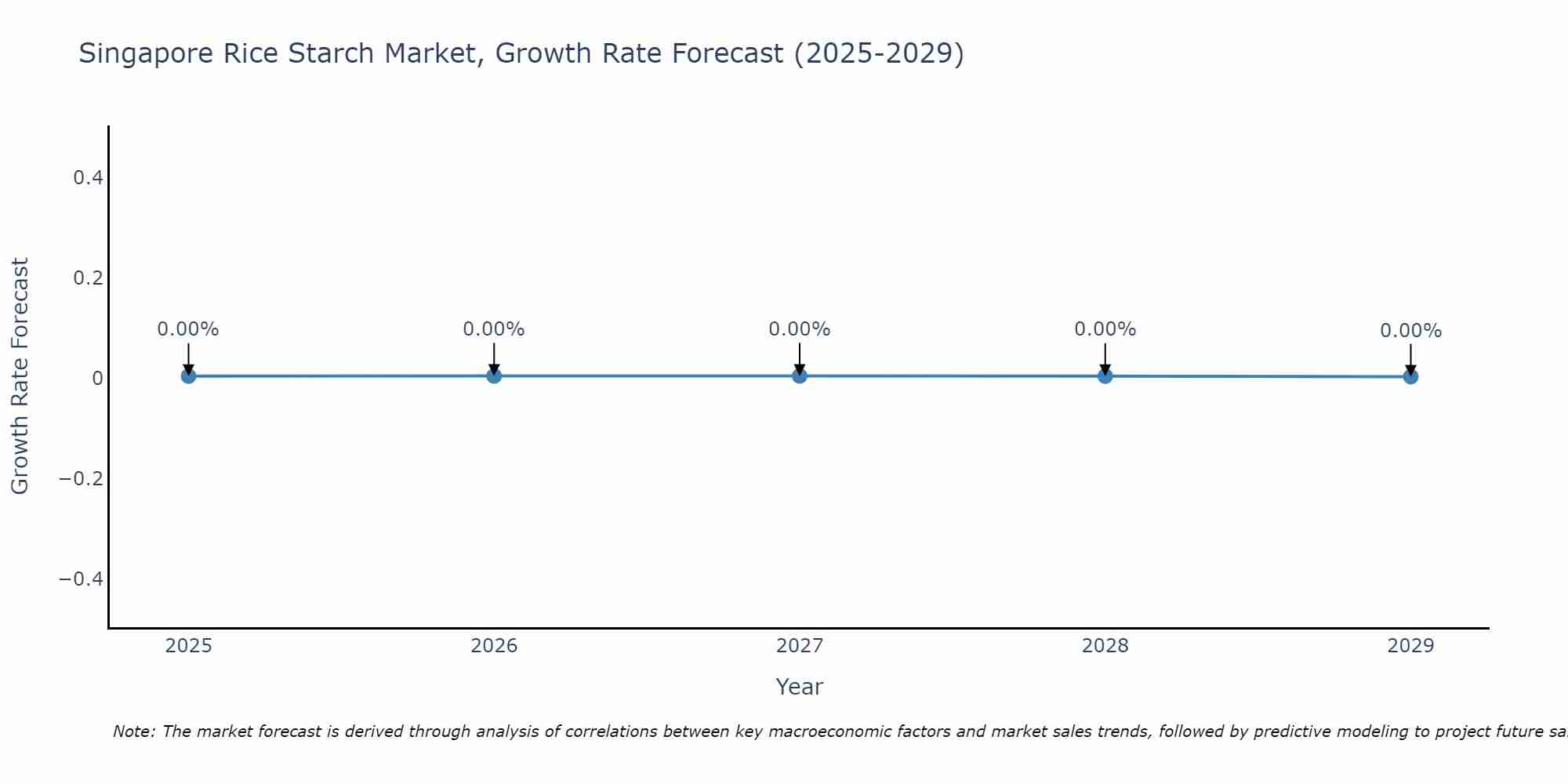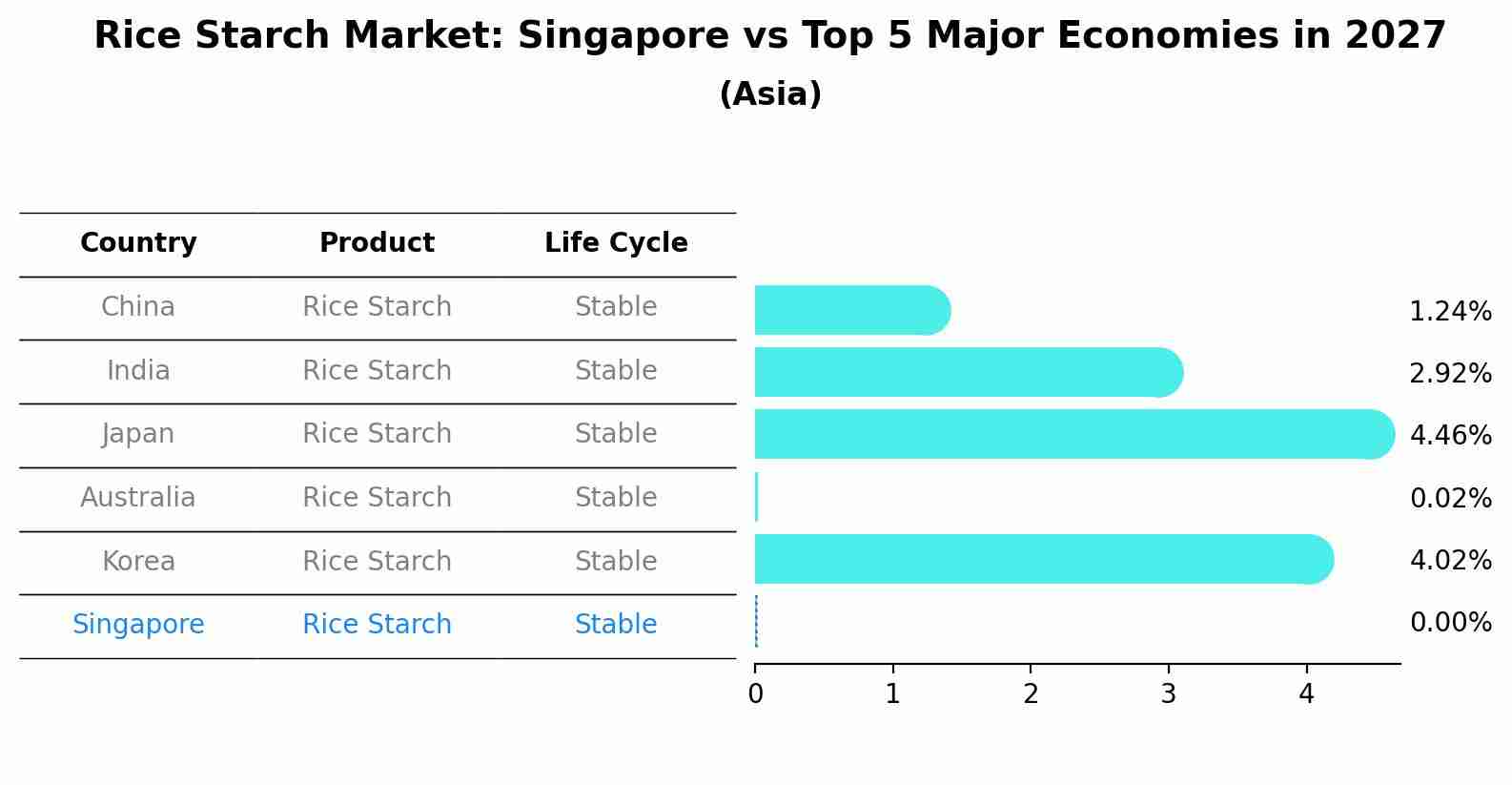Singapore Rice Starch Market | Size, COVID-19 IMPACT, Forecast, Companies, Industry, Analysis, Growth, Revenue, Value, Share & Trends
| Product Code: ETC179266 | Publication Date: Jan 2022 | Updated Date: Aug 2025 | Product Type: Market Research Report | |
| Publisher: 6Wresearch | Author: Ravi Bhandari | No. of Pages: 70 | No. of Figures: 35 | No. of Tables: 5 |
Singapore Rice Starch Market Size Growth Rate
The Singapore Rice Starch Market is projected to witness mixed growth rate patterns during 2025 to 2029. The growth rate begins at 0.00% in 2025, climbs to a high of 0.00% in 2027, and moderates to 0.00% by 2029.

Rice Starch Market: Singapore vs Top 5 Major Economies in 2027 (Asia)
By 2027, the Rice Starch market in Singapore is anticipated to reach a growth rate of 0.00%, as part of an increasingly competitive Asia region, where China remains at the forefront, supported by India, Japan, Australia and South Korea, driving innovations and market adoption across sectors.

Singapore Rice Starch Market Synopsis
Rice starch is a staple in the Asian food industry and is commonly used in a wide range of products, including noodles, desserts, and sauces. Given Singapore multicultural cuisine, rice starch remains a significant ingredient. The market is likely to remain stable, with a focus on quality and sourcing sustainable rice varieties.
Drivers of the Market
Rice starch is a staple ingredient in Asian cuisine and is widely used in food processing. In Singapore, the market for rice starch is expected to remain robust due to the popularity of rice-based dishes. Additionally, rice starch`s application in the manufacturing of snacks, confectionery, and gluten-free products will contribute to its growth. As consumers continue to seek convenience and diverse food options, the rice starch market in Singapore is poised for steady expansion.
Challenges of the Market
The Singapore rice starch market may encounter challenges associated with competition from other starches and thickeners, such as corn starch and tapioca starch. Manufacturers of rice starch products will need to focus on product differentiation and quality to maintain a strong market position.
COVID-19 Impact on the Market
The Singapore rice starch market experienced fluctuations during the COVID-19 pandemic, primarily due to disruptions in supply chains. These disruptions impacted the availability and pricing of rice starch. However, the market adapted as manufacturers explored alternative sourcing options and optimized their distribution networks. Rice starch remained a key ingredient in various food products, and its demand remained consistent. As the situation improves, the rice starch market is expected to recover and continue to serve the food industry.
Key Players in the Market
Rice starch is a versatile ingredient in the food industry, and companies like Thai Flour Industry and Riceland play a crucial role in supplying rice starch for use in products like rice cakes, sauces, and desserts in the Singaporean market.
Key Highlights of the Report:
- Singapore Rice Starch Market Outlook
- Market Size of Singapore Rice Starch Market, 2023
- Forecast of Singapore Rice Starch Market, 2030
- Historical Data and Forecast of Singapore Rice Starch Revenues & Volume for the Period 2020-2030
- Singapore Rice Starch Market Trend Evolution
- Singapore Rice Starch Market Drivers and Challenges
- Singapore Rice Starch Price Trends
- Singapore Rice Starch Porter's Five Forces
- Singapore Rice Starch Industry Life Cycle
- Historical Data and Forecast of Singapore Rice Starch Market Revenues & Volume By Type for the Period 2020-2030
- Historical Data and Forecast of Singapore Rice Starch Market Revenues & Volume By Native for the Period 2020-2030
- Historical Data and Forecast of Singapore Rice Starch Market Revenues & Volume By Modified for the Period 2020-2030
- Historical Data and Forecast of Singapore Rice Starch Market Revenues & Volume By Others for the Period 2020-2030
- Historical Data and Forecast of Singapore Rice Starch Market Revenues & Volume By Application for the Period 2020-2030
- Historical Data and Forecast of Singapore Rice Starch Market Revenues & Volume By Food and Beverages for the Period 2020-2030
- Historical Data and Forecast of Singapore Rice Starch Market Revenues & Volume By Pharmaceuticals for the Period 2020-2030
- Historical Data and Forecast of Singapore Rice Starch Market Revenues & Volume By Cosmetics and Personal Care for the Period 2020-2030
- Historical Data and Forecast of Singapore Rice Starch Market Revenues & Volume By Textiles for the Period 2020-2030
- Historical Data and Forecast of Singapore Rice Starch Market Revenues & Volume By Others for the Period 2020-2030
- Singapore Rice Starch Import Export Trade Statistics
- Market Opportunity Assessment By Type
- Market Opportunity Assessment By Application
- Singapore Rice Starch Top Companies Market Share
- Singapore Rice Starch Competitive Benchmarking By Technical and Operational Parameters
- Singapore Rice Starch Company Profiles
- Singapore Rice Starch Key Strategic Recommendations
Frequently Asked Questions About the Market Study (FAQs):
1 Executive Summary |
2 Introduction |
2.1 Key Highlights of the Report |
2.2 Report Description |
2.3 Market Scope & Segmentation |
2.4 Research Methodology |
2.5 Assumptions |
3 Singapore Rice Starch Market Overview |
3.1 Singapore Country Macro Economic Indicators |
3.2 Singapore Rice Starch Market Revenues & Volume, 2020 & 2030F |
3.3 Singapore Rice Starch Market - Industry Life Cycle |
3.4 Singapore Rice Starch Market - Porter's Five Forces |
3.5 Singapore Rice Starch Market Revenues & Volume Share, By Type, 2020 & 2030F |
3.6 Singapore Rice Starch Market Revenues & Volume Share, By Application, 2020 & 2030F |
4 Singapore Rice Starch Market Dynamics |
4.1 Impact Analysis |
4.2 Market Drivers |
4.2.1 Growing demand for clean-label and natural ingredients in food products |
4.2.2 Increasing adoption of rice starch in pharmaceutical and cosmetic industries |
4.2.3 Rising health consciousness leading to the preference for gluten-free and non-GMO products |
4.3 Market Restraints |
4.3.1 Fluctuating prices of raw materials impacting production costs |
4.3.2 Intense competition from alternative starch sources like corn and potato starch |
4.3.3 Regulatory challenges related to food safety and quality standards |
5 Singapore Rice Starch Market Trends |
6 Singapore Rice Starch Market, By Types |
6.1 Singapore Rice Starch Market, By Type |
6.1.1 Overview and Analysis |
6.1.2 Singapore Rice Starch Market Revenues & Volume, By Type, 2020-2030F |
6.1.3 Singapore Rice Starch Market Revenues & Volume, By Native, 2020-2030F |
6.1.4 Singapore Rice Starch Market Revenues & Volume, By Modified, 2020-2030F |
6.1.5 Singapore Rice Starch Market Revenues & Volume, By Others, 2020-2030F |
6.2 Singapore Rice Starch Market, By Application |
6.2.1 Overview and Analysis |
6.2.2 Singapore Rice Starch Market Revenues & Volume, By Food and Beverages, 2020-2030F |
6.2.3 Singapore Rice Starch Market Revenues & Volume, By Pharmaceuticals, 2020-2030F |
6.2.4 Singapore Rice Starch Market Revenues & Volume, By Cosmetics and Personal Care, 2020-2030F |
6.2.5 Singapore Rice Starch Market Revenues & Volume, By Textiles, 2020-2030F |
6.2.6 Singapore Rice Starch Market Revenues & Volume, By Others, 2020-2030F |
7 Singapore Rice Starch Market Import-Export Trade Statistics |
7.1 Singapore Rice Starch Market Export to Major Countries |
7.2 Singapore Rice Starch Market Imports from Major Countries |
8 Singapore Rice Starch Market Key Performance Indicators |
8.1 Percentage of food products using rice starch as an ingredient |
8.2 Number of new product launches containing rice starch |
8.3 Export volume of rice starch products |
8.4 Research and development investment in rice starch innovations |
8.5 Consumer awareness and perception of rice starch as a healthy ingredient |
9 Singapore Rice Starch Market - Opportunity Assessment |
9.1 Singapore Rice Starch Market Opportunity Assessment, By Type, 2020 & 2030F |
9.2 Singapore Rice Starch Market Opportunity Assessment, By Application, 2020 & 2030F |
10 Singapore Rice Starch Market - Competitive Landscape |
10.1 Singapore Rice Starch Market Revenue Share, By Companies, 2023 |
10.2 Singapore Rice Starch Market Competitive Benchmarking, By Operating and Technical Parameters |
11 Company Profiles |
12 Recommendations |
13 Disclaimer |
- Single User License$ 1,995
- Department License$ 2,400
- Site License$ 3,120
- Global License$ 3,795
Search
Thought Leadership and Analyst Meet
Our Clients
Related Reports
- Germany Breakfast Food Market (2026-2032) | Industry, Share, Growth, Size, Companies, Value, Analysis, Revenue, Trends, Forecast & Outlook
- Australia Briquette Market (2025-2031) | Growth, Size, Revenue, Forecast, Analysis, Trends, Value, Share, Industry & Companies
- Vietnam System Integrator Market (2025-2031) | Size, Companies, Analysis, Industry, Value, Forecast, Growth, Trends, Revenue & Share
- ASEAN and Thailand Brain Health Supplements Market (2025-2031) | Strategy, Consumer Insights, Analysis, Investment Trends, Opportunities, Growth, Size, Share, Industry, Revenue, Segments, Value, Segmentation, Supply, Forecast, Restraints, Outlook, Competition, Drivers, Trends, Demand, Pricing Analysis, Competitive, Strategic Insights, Companies, Challenges
- ASEAN Bearings Market (2025-2031) | Strategy, Consumer Insights, Analysis, Investment Trends, Opportunities, Growth, Size, Share, Industry, Revenue, Segments, Value, Segmentation, Supply, Forecast, Restraints, Outlook, Competition, Drivers, Trends, Demand, Pricing Analysis, Competitive, Strategic Insights, Companies, Challenges
- Europe Flooring Market (2025-2031) | Outlook, Share, Industry, Trends, Forecast, Companies, Revenue, Size, Analysis, Growth & Value
- Saudi Arabia Manlift Market (2025-2031) | Outlook, Size, Growth, Trends, Companies, Industry, Revenue, Value, Share, Forecast & Analysis
- Uganda Excavator, Crane, and Wheel Loaders Market (2025-2031) | Strategy, Consumer Insights, Analysis, Investment Trends, Opportunities, Growth, Size, Share, Industry, Revenue, Segments, Value, Segmentation, Supply, Forecast, Restraints, Outlook, Competition, Drivers, Trends, Demand, Pricing Analysis, Competitive, Strategic Insights, Companies, Challenges
- Rwanda Excavator, Crane, and Wheel Loaders Market (2025-2031) | Strategy, Consumer Insights, Analysis, Investment Trends, Opportunities, Growth, Size, Share, Industry, Revenue, Segments, Value, Segmentation, Supply, Forecast, Restraints, Outlook, Competition, Drivers, Trends, Demand, Pricing Analysis, Competitive, Strategic Insights, Companies, Challenges
- Kenya Excavator, Crane, and Wheel Loaders Market (2025-2031) | Strategy, Consumer Insights, Analysis, Investment Trends, Opportunities, Growth, Size, Share, Industry, Revenue, Segments, Value, Segmentation, Supply, Forecast, Restraints, Outlook, Competition, Drivers, Trends, Demand, Pricing Analysis, Competitive, Strategic Insights, Companies, Challenges
Industry Events and Analyst Meet
Whitepaper
- Middle East & Africa Commercial Security Market Click here to view more.
- Middle East & Africa Fire Safety Systems & Equipment Market Click here to view more.
- GCC Drone Market Click here to view more.
- Middle East Lighting Fixture Market Click here to view more.
- GCC Physical & Perimeter Security Market Click here to view more.
6WResearch In News
- Doha a strategic location for EV manufacturing hub: IPA Qatar
- Demand for luxury TVs surging in the GCC, says Samsung
- Empowering Growth: The Thriving Journey of Bangladesh’s Cable Industry
- Demand for luxury TVs surging in the GCC, says Samsung
- Video call with a traditional healer? Once unthinkable, it’s now common in South Africa
- Intelligent Buildings To Smooth GCC’s Path To Net Zero


















